Paint and fish tanks rarely mix, but when they do, you want to make sure the paint is safe for both you and your fish. Not only can paint chemically react with your fish tank water, but it can also warp the glass and cause cracks which are dangerous for both you and your fish. You want to make sure that whatever paint you use is safe for the environment that surrounds the fish tank.
In this buyer’s guide, we’ll take a look at what makes paint safe for aquariums and how you can find the best paint for your fish tank. We will also go over a few reviews of the best aquarium-safe paint to give you a general overview of what may be good for your aquarium.
Comparison Table of the 5 Best Aquarium Safe Paint
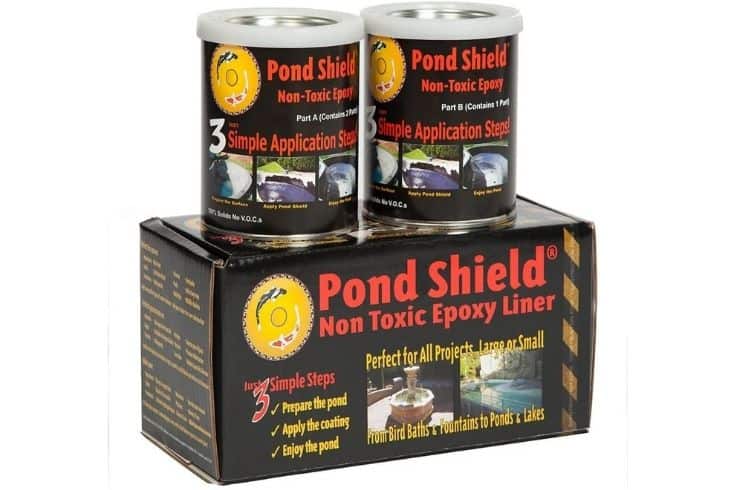
BRAND
Pond Armor Non-Toxic Pond Shield
DETAILS
- Two-part epoxy paint
- Wide range of finishes and colors
- Strong adhesion, excellent coverage, and long-lasting durability
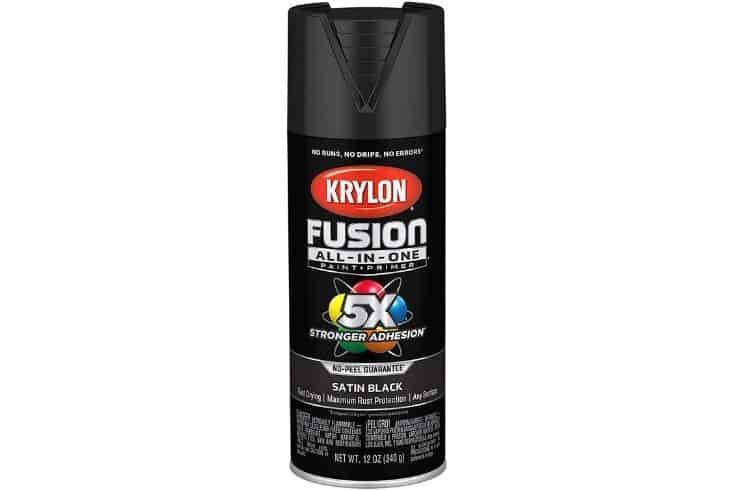
Krylon Fusion Aquarium Safe Paint
- Quick-drying spray paint
- Good adhesion to most surfaces
- Environmentally safe
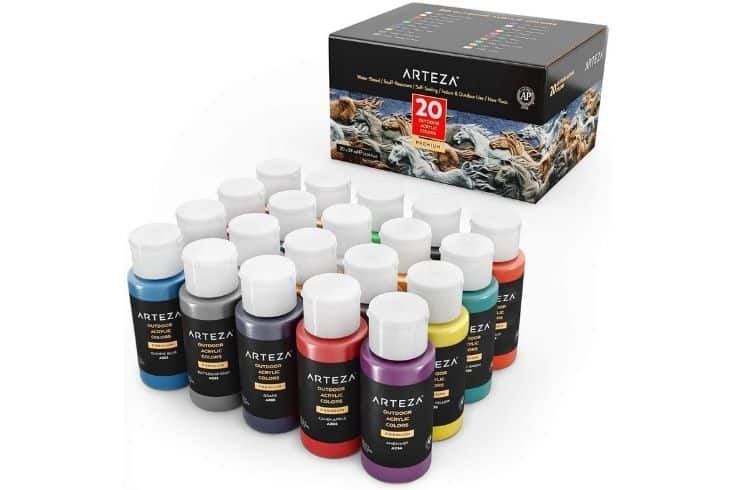
Arteza Outdoor Acrylic Paint
- Water-based acrylic paint
- Adheres to glass and plastic
- Non-toxic
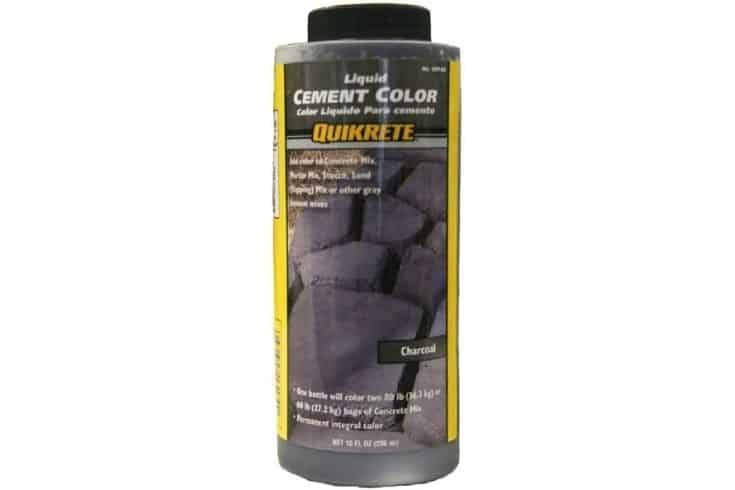
Quickrete Liquid Concrete Paint with Drylok
- Concrete paint
- Quick-drying
- Weatherproof
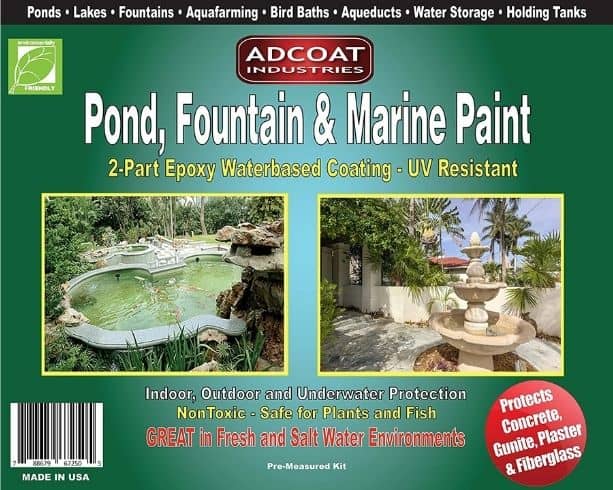
AdCoat Pond, Fountain & Marine Paint – 2-Part Acrylic Epoxy
- Two-part acrylic epoxy paint
- Formulated to resist most chemicals
- Tough finish
Best Aquarium-Safe Paint: Top Recommendations
Now that you know what to look for in an aquarium-safe paint, let’s take a look at some possible options for your fish tank.
1. Pond Armor Non-Toxic Pond Shield Epoxy Paint

- Two-part epoxy paint
- Wide range of finishes and colors
- Strong adhesion, excellent coverage, and long-lasting durability
If you’re looking for practical and affordable paint for your fish tank, Pond Armor Non-Toxic Pond Shield is the product you’ll want to consider. This two-part epoxy paint comes in a wide range of finishes and colors that can be mixed to achieve the perfect shade.
It’s one of the most effective paints on the market thanks to its strong adhesion, excellent coverage, and long-lasting durability. The two-component paint system ensures that your fish tank will last for years without any noticeable degradation in appearance or performance. Its strong adherence means that it can be used on a wide range of surfaces such as wood, metal, and glass.
This product also goes on extremely smooth thanks to its thick consistency, which helps prevent paint from peeling and dripping. Even if you choose to apply a coat of paint in freezing cold or extremely warm conditions, this waterproof, durable paint will withstand extreme weather conditions to keep your fish tank looking great at all times.
PROS
- Durable
- Adheres well
- Weatherproof
CONS
- Thick consistency can take a little getting used to
2. Krylon Fusion Aquarium Safe Paint For Plastic

- Quick-drying spray paint
- Good adhesion to most surfaces
- Environmentally safe
One of the key advantages of spray paints is that they can be applied to practically any surface. Therefore, if you’re looking for the most efficient way to paint your fish tank’s walls, Krylon Fusion Aquarium Safe Paint is an excellent choice. This type of paint is specially formulated to adhere to plastic surfaces such as your fish tank, allowing you the freedom of decorating in any way that you see fit.
It goes on flexibly and dries quickly to a matte finish with no need for additional coats or topcoats. Several reviewers have commented on its excellent coverage and how a single coat is usually sufficient to achieve the desired effect. Not only is this paint environmentally safe, but it is also non-toxic and completely free of any chemicals that are harmful to you or your pets.
This quick-drying paint comes in a wide range of finishes and colors, which you can mix to achieve the perfect tone. If you’ve previously had problems with paints peeling off your fish tank’s plastic surface, this paint will completely eliminate that issue. With a wide array of popular colors and finishes available, you’ll also never be at a loss for how to decorate your aquarium.
PROS
- Convenient
- Excellent coverage
- Dried quickly
CONS
- No mediaNot created specifically for use in aquariums, though it is non-toxic and safe trays
3. Arteza Outdoor Acrylic Paint

- Water-based acrylic paint
- Adheres to glass and plastic
- Non-toxic
If you’re looking to decorate your tank with a pop of color, Arteza Outdoor Acrylic Paint is an excellent choice. This high-quality, opaque watercolor paint is specially formulated for use with a wide range of surfaces, including plastic and glass aquariums. If you’ve ever wanted to paint your tank walls a bright color, we recommend giving Arteza a try.
The paint itself goes on smoothly yet thickly to create a solid coat that won’t drip or crack. It has a high adhesion that prevents it from peeling or fading in the water, ensuring that your tank will stay looking great for years. The acrylic paint also dries quickly to a high-gloss finish that’s tough enough to resist even the most extreme weather conditions.
It comes in a wide range of bright and vibrant colors, all of which are safe for use with fish and other aquatic animals. The fact that it is completely non-toxic means that it won’t cause any damage to your fish or their environment. It’s also specially formulated to work with all Arteza accessories, allowing you to customize even further how you want your aquarium designed.
PROS
- Wide range of colors
- High gloss
CONS
- Not formulated specifically for aquariums
4. Quickrete Liquid Concrete Paint with Drylok

- Concrete paint
- Quick-drying
- Weatherproof
Though the Quickrete is formulated for use with concrete, we decided to include it in this guide because of the great features that make it an excellent choice for painting your fish tank. Specifically, we like how easy and smooth it goes on to achieve a solid coat that’s tough and durable enough to resist water damage. The fast-drying paint also won’t crack or peel off even when exposed to extreme weather conditions.
Many reviewers have also praised its rich, even coloration that makes it difficult for the paint to chip or scratch off. Since it is waterproof, your fish tank walls will remain looking great at all times. The Quickrete coating also works as a protective barrier against any stains from rusting metal components inside of your aquarium.
The best part about the Quickrete is that it can be applied easily by brush, roller, or spray. The paint comes in a wide range of both classic and modern colors that will allow you to completely transform your fish tank’s appearance. Once applied, it dries to a rich, even tone that will prevent peeling or chipping. A little bit goes a long way when it comes to this paint!
PROS
- Long-lasting
- Highly pigmented
- Very durable
CONS
- A little finicky for first-timers
5. AdCoat Pond, Fountain & Marine Paint – 2-Part Acrylic Epoxy

- Two-part acrylic epoxy paint
- Formulated to resist most chemicals
- Tough finish
While some paints are only suitable for home decoration, the AdCoat is an epoxy paint that’s formulated specifically for use with ponds and other aquatic features. If you’re looking to completely revamp your fish tank without having to do extensive renovation work, we recommend giving the AdCoat a try.
The fact that it is completely safe for your fish and aquarium plants makes it an excellent choice for any aquarium owner. If you’re looking to create a realistic underwater landscape in your tank, this is the paint you’ll want to use. This paint is specially formulated to resist most chemicals, including various acids and alkalis that are commonly found in tap water.
As a bonus, it’s also waterproof, making it an excellent choice for any outdoor decoration or feature. We recommend testing it on a small area first to ensure that it comes out the way you want. Since this paint is two-parts, you’ll need to follow the mixing instructions carefully in order to get it right. However, if done correctly, you’ll find that the AdCoat forms an extremely tough and long-lasting finish.
PROS
- Formulated for aquariums
- Completely plant and fish-safe
- Non-reactive with most chemicals
CONS
- On the pricier end of things
What Makes Paint Aquarium-Safe?
Before delving into our reviews and buyer’s guide, we need to first discuss what makes a paint-safe for aquariums. Here are some things to think about when choosing a paint for your aquarium:
Ingredients
The key to any paint formula is its ingredients. There are several kinds of paint that specifically advertise themselves as “fish safe”. These are usually water-based paints or latex-based acrylic paints, both of which are generally considered safe for aquariums.
The main harmful chemicals to avoid are ethylene glycol, zinc chromate, metallic salts, and lead-based paints. Lead in particular is notoriously toxic and has a reputation for being one of the most deadly chemicals you can find in a home. Even if the paint does not release any of these elements while it’s drying, it can still be an issue if the fish tank becomes cracked over time, as a cracked tank is more likely to leach chemicals that can harm your fish.
Type of Paint
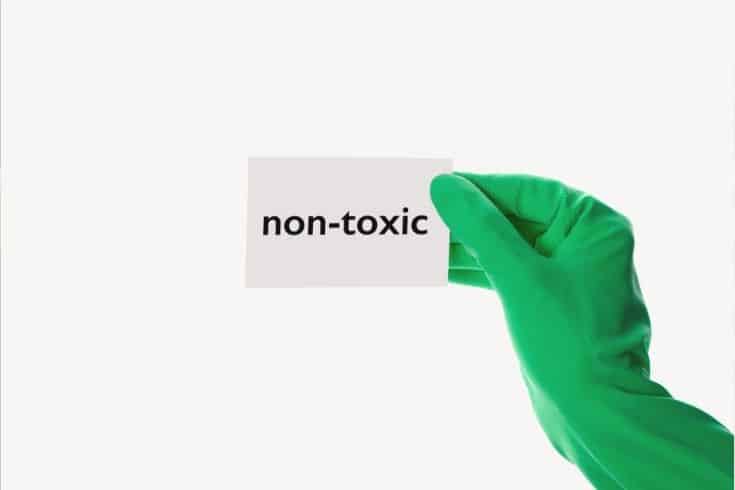
Paint is commonly classified based on its product type and the main types of non-toxic paint for fish tanks include acrylic, latex, epoxy, and shellac. Latex and acrylic paints are widely considered to be the safest paints since they do not contain any harmful chemicals that can be released when in contact with water, though you should always check your paint’s ingredients before use.
On the other hand, although oil-based paints may appear to be a similar type of liquid paint, they often contain chemicals that are toxic to fish and should not be used in an aquarium. However, a rubber-based paint such as latex paint that is designed for use with an oil-based primer is safe to be used in aquariums. You can also opt for a non-toxic epoxy paint if the paint will be submerged in water.
Something you should absolutely steer clear of, however, is mold-resistant paint. These paints contain fungicides such as thiabendazole that can be harmful to fish and other aquatic life.
Durability
The lightfastness or “fade resistance” is how long the paint will remain unaffected by sunlight. If the paint is not physically durable or chemically resistant to UV ray exposure, it will begin breaking down and fading in color over time. The safest paints for fish tanks, such as latex and acrylic paints, will typically also be highly lightfast thanks to their high resistance to sunlight.
Another important aspect of durable paint is its ability to resist scratches and chips from normal wear and tear. Paints with a thin, watery consistency are more likely to chip or scratch over time. This can be dangerous as fish may mistake paint chips for food and eat them, causing digestion problems. A thicker waterproof paint with higher viscosity is less likely to chip or scratch and is therefore generally safe for aquariums.
The final durability aspect to look for is resistance to chemicals such as oil and fish tank salt. If you’re using paint inside aquariums, it’s important to make sure the paint can withstand any potential chemical reactions it may have with the water and fish tank salt. Though there’s no direct correlation between price point and quality, many low-budget paints will not be as durable and chemical-resistant.
Appearance
Let’s be honest: the most important aspect of any paint is how good it looks on your fish tank. Nobody wants to spend time and money on a project that will look unappealing when they’re done, so appearance should be one of your top considerations when choosing paints for aquariums. Thankfully, aquarium paints come in a wide range of colors and finishes to suit your preferences.
Cream colors are perfect if you want a natural-looking color that fits into your house, while darker colors can be appealing if you want to create some contrast – picture a black color scheme fish tank with goldfish inside – doesn’t that sound cool? Of course, a stronger color such as red might not go well with your fish tank’s lighting system, so it’s important to consider all possible ideas before you start painting.
The finish of your paint can also impact the appearance of your fish tank. Matte paint will produce a subtle, non-reflective look that hides any gaps between the paint and your aquarium walls, creating a smooth finish. Meanwhile, something exciting like glow-in-the-dark paint can attract more attention to your fish tank and can be a great way to show off your favorite pets.
Feel free to get creative with your paint colors and finishes as long as you can find a way to make it look good both by itself and with your fish tank’s lighting!
Compatibility With Aquarium Decorations
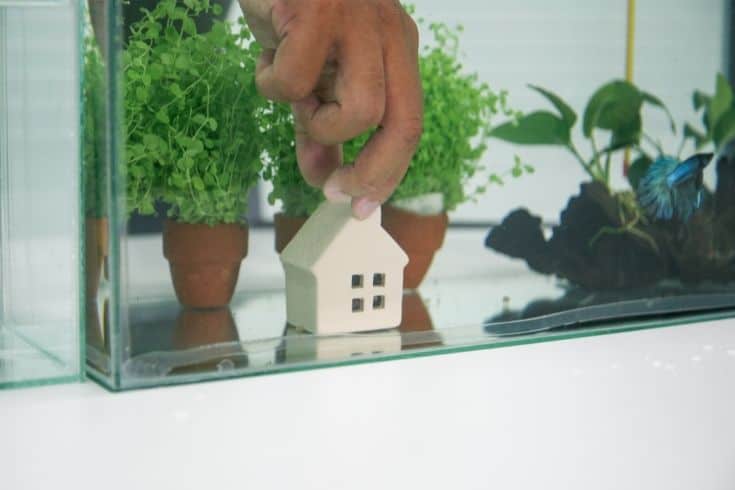
Tank decorations and aquarium ornaments have the potential to get in the way of your paint job, which can result in loss of adhesion. Therefore, fish tanks that are home to difficult surfaces and coated items will require a more specialized paint. For instance, paints that offer rust protection are useful for tanks that are home to rust-prone items – think of aquarium-themed clocks with metal fixtures.
Additionally, many fishkeepers attempt to replicate their fish’s natural habitat using rocks, flowerpots, driftwood, and pebbles. These surfaces can be difficult to paint, you’ll want to opt for a high adhesion primer that will stick directly to the surface. Primers are also great for aquariums that already have paint layers, as they can help hide any cracks or chips in the paint and strengthen its overall effect.
Reef tanks are another tricky scenario. Most paints are not recommended for reef tanks, as they will eventually dissolve in the saltwater mix, creating a deadly environment dangerous for both you and your fish. If a paint job is absolutely necessary for your reef tank, you’ll need to consider high-quality paints with high resistance to saltwater.
Conclusion
If you’re looking to completely transform the appearance of your fish tank without sacrificing safety, we recommend any of these five paint options. Whether you want a tough protective finish or a stunning color change that makes your aquarium stand out, you’ll find that one works best for your needs.
Did you enjoy this article? If so, please take a moment to share this article with your friends and family! Drop us a comment as well – we’d love to hear from you!
